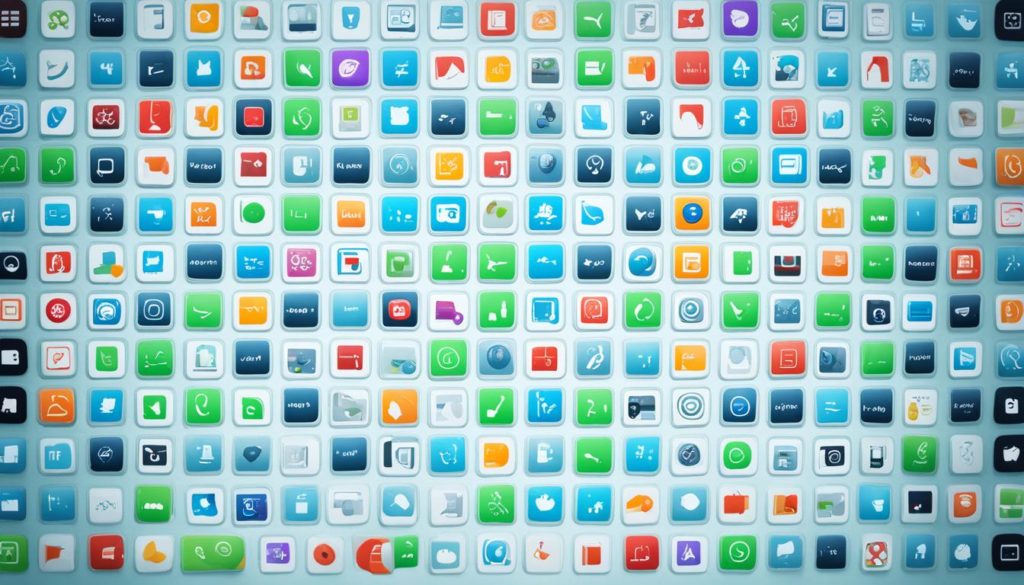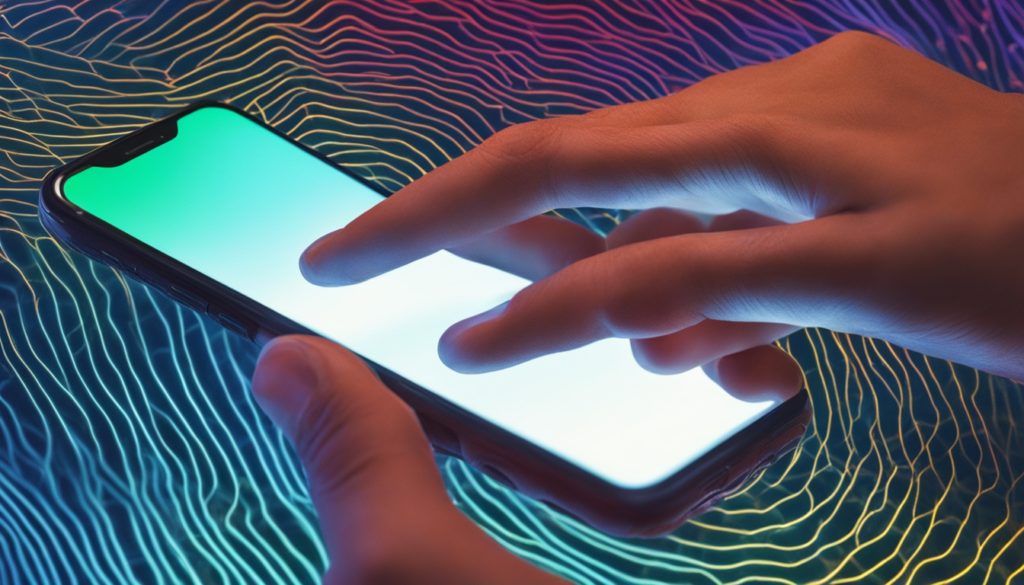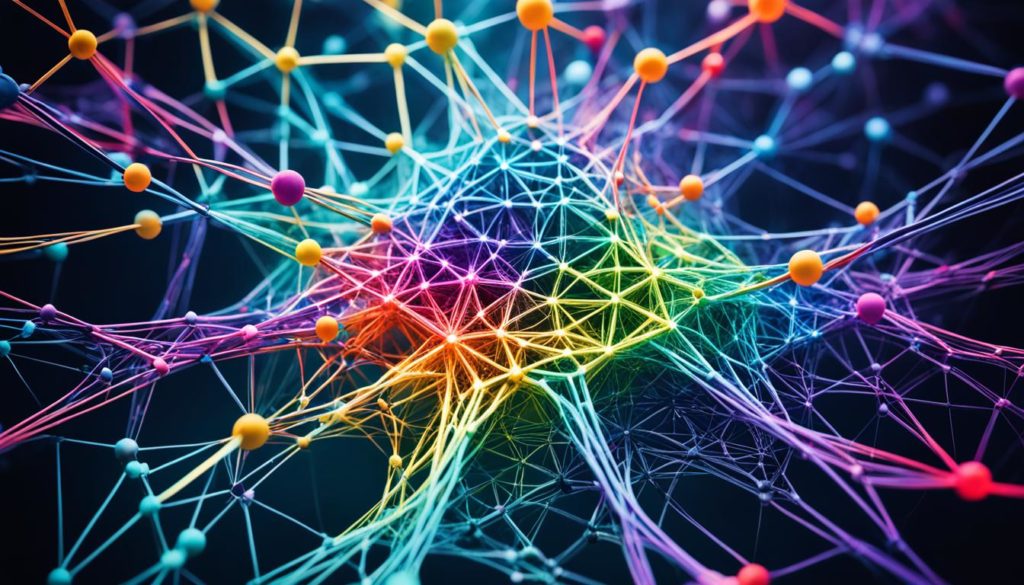
Nearly 80% of our phone use is by touch, not sight. This is thanks to haptic feedback technology. It gives us gentle buzzes when a message comes in or mimics the feeling of a real-life experience in a game. Haptic apps make digital things feel real by conveying information like temperature and texture through touch.
Haptic feedback apps mix innovation with our senses, breaking new ground in device use. They have evolved from old arcade games to today’s touch feedback apps. These apps are not just for fun. They also make digital experiences more intuitive and engaging for us all.
Key Takeaways
- Haptic feedback technology enhances user experiences by providing non-auditory, tactile information.
- Best haptic apps contribute significantly to daily device interactions such as receiving notifications or gaming.
- Touch feedback applications are crucial for creating immersive environments that engage multiple senses.
- Haptic feedback systems not only improve accessibility but also well-being through innovative use in various apps.
- Tactile feedback software is making strides by delivering sophisticated experiences in innovative ways.
Exploring the World of Haptic Technology
Haptic technology has changed a lot, starting in arcade games. Think about how Sega’s Moto-Cross made you feel every hit. Or how Nintendo 64’s Rumble Pak made games feel real. These were the first steps to today’s advanced haptic feedback devices.
Haptic feedback is now in gaming and medicine, making big changes. For instance, haptic gloves in VR feel almost real. This improves how real a virtual world feels. For those interested, top haptic feedback apps offer great insights.
In healthcare, haptic tech helps in remote surgeries. Robots with haptic abilities let surgeons feel as if they’re touching real tissues. This gives them a lot of precision in their work. This was hard to imagine years ago.
We see haptic technology in everyday stuff like phones and cars. Phones use it to make games and apps feel more real. Cars use it to make driving safer. It lets drivers focus on the road while using controls.
The future of haptic technology is exciting and full of potential. It’s making games more real and surgeries safer. With devices and top haptic feedback apps, digital and real worlds are coming closer.
Accessibility Innovations: Haptic Apps for the Sensory Impaired
Exploring the world of accessibility, we find haptic feedback apps making big changes. They do more than just improve things; they change how people with sensory impairments experience the world. These apps help users understand their surroundings through touch.
The Sunu Band: A Leap in Sensory Technology
The Sunu Band is more than a gadget; it’s a key to better movement for people who can’t see well. It uses sonar and vibrations to warn of objects up to 13 feet away. This information helps users avoid obstacles, making it a big improvement over using a cane.
Organizations like the Perkins School for the Blind have praised the Sunu Band. It’s setting new standards in accessibility technology for people with sensory challenges.
Revolutionizing Navigation with Haptics
Haptic feedback apps play a big role in improving everyday life. They make moving around safer and more confident. These tools offer new ways to interact with the environment that weren’t possible before.
They do more than make up for lost senses. They change the game by boosting independence and empowerment.
Here’s a look at how the Sunu Band uses haptic feedback:
| Feature | Function | Impact |
|---|---|---|
| Sonar Sensor | Detects obstacles | Enhances spatial awareness |
| Vibration Feedback | Indicates object proximity | Improves safety and mobility |
| Wearable Design | Portable and easy to use | Supports active, independent lifestyle |
There’s a big shift happening in assistive tech, especially with haptic feedback apps. They are creating real change for people with sensory impairments. As these technologies grow, they promise even bigger things for accessibility in the future.
Revolutionizing Surgery with Haptic Feedback Systems
Advanced surgical robotics with haptic feedback systems are changing surgery dramatically. These systems give surgeons control and sensory feedback like traditional surgery. This is because of the haptic actuators.
The key to this tech is providing detailed tactile feedback. It helps in identifying different tissue types. It also helps in sensing resistance and pressure needed for delicate surgical tasks.
This technology greatly improves surgical precision. It reduces the risk of harming nearby tissues. This means patients get better faster.
Using haptic feedback in surgical robotics also means surgeries can be done remotely. Surgeions can operate on patients far away. This can improve access to expert surgery in places that need it. Learn more about this at advanced haptic actuators in robotics.
| Feedback Type | Benefits in Surgery |
|---|---|
| Force Feedback | Allows perception of resistance, enhancing touch sensation and precision. |
| Tactile Feedback | Assists in differentiating tissue types, which aids precise decision-making. |
| Kinesthetic Feedback | Improves awareness of instrument positioning, crucial for complex maneuvers. |
Training with advanced surgical robotics and haptic feedback is key for new surgeons. It simulates real-life operations. This builds their confidence and skill.
In conclusion, haptic technology and surgical robotics are advancing. They are making surgery safer and improving patient care. This technology promises a future with fewer surgical errors.
The Emergence of Haptic Feedback Apps in Mobile Gaming
As we explore the digital world, real and virtual experiences seem to merge. This is largely due to haptic feedback technology in mobile gaming apps. The technology makes gaming more vivid and immersive by simulating touch through vibrations and movements.
Discover more about haptic feedback technology and how it’s changing our experience across various platforms.
Enhancing Gameplay with Tactile Responses
Haptic feedback in gaming apps makes playing more engaging by providing tactile responses. It makes games feel more real and offers clues to perform better and enjoy more.
Interhaptics: Bridging the Void Between Android & iOS Haptics
Interhaptics is a key player in making haptic feedback the same across iOS and Android devices. It lets developers give every mobile gaming apps player a united tactile experience. This means everyone, no matter their device, gets to enjoy the same fun haptic feedback.
| Feature | Impact on Gaming | Benefit |
|---|---|---|
| Unified Cross-Platform Haptics | Consistent tactile feedback across different devices | Equal gaming experience for all users |
| Tactile Design Tools | Customizable haptic patterns | Enhances game immersion and interactivity |
| Real-time Haptic Effects | Immediate feedback from in-game actions | Increases realism and player satisfaction |
Integrating haptic feedback technology into mobile gaming is just the start. It’s making games more engaging and keeping players coming back for more. We can’t wait to see how it will grow and change mobile gaming in the future.
Understanding the Role of Haptic Feedback in Daily Interactions
We run into haptic feedback apps more than we might think in our daily routines. These apps are key in making our everyday encounters with devices better. They make them easy to understand and more fun. For example, the light taps you feel when messaging on your phone to the deep vibrations in game controllers. These touch feedback applications shape how we deal with technology.
Adding touch feedback to our daily device use makes interacting with our digital world more hands-on. It’s amazing how small vibrations can confirm actions, cut down on mistakes, and boost how happy we are with our devices. All in ways that are subtle but powerful.
| Device Type | Interaction | Role of Haptic Feedback |
|---|---|---|
| Smartphones | Typing, Gesture Navigation | Confirms actions, enhances text entry accuracy |
| Wearables | Activity Tracking, Notifications | Provides discreet alerts, encourages user engagement |
| Gaming Controllers | Gameplay Interaction | Simulates real-world experiences, increases immersion |
As we keep using different devices, haptic feedback apps will likely get even more common. They will become a bigger part of how we interact with devices every day. This smooth mixing not only makes using devices better but also leads to smarter, more reactive tech in our lives.
Mindfulness and Meditation: Haptic Apps for Well-being
Haptic technology has become key in building mindfulness and meditation apps. Apps like Breathe for Apple Watch use this tech. They use gentle, touch-based feedback to improve our relaxation practices.
Breathe for Apple Watch: The Gentle Reminder to Relax
Breathe for Apple Watch shows how haptic apps can better mindfulness practice. They use soft taps to guide users through breathing exercises. This helps increase focus and calm.
The Tactile Approach to Mindfulness
Wellness tools now often include haptic feedback. This creates a physical connection with meditation content. It helps keep the user’s mind in the present moment, crucial for successful meditation.
| App Name | Features | User Feedback |
|---|---|---|
| Breathe for Apple Watch | Guided Breathing, Haptic Feedback, Heart Rate Monitoring | Highly rated for ease of use and effectiveness in daily stress management |
| Other Leading Haptic Feedback Apps | Customizable vibrations, Activity reminders | Positive reviews for personalized options and integration with daily activities |
Haptic feedback is changing wellness routines with apps like Breathe for Apple Campaign. These apps make meditation easier and more interactive. The physical feedback they provide helps users on their journey to better mental health.
Haptic Feedback Apps: Creating Touch Without Contact
In the world of user experience, Ultrahaptics stands out for its advanced haptic feedback technology. Using ultrasonic waves, it lets users feel touch without direct contact. It’s like a soft breeze you can feel, created by sound waves.
Ultrahaptics: A New Dimension of Touch
Ultrahaptics shows us a new way to engage with digital spaces. It uses an invisible touch in mid-air, not traditional touch-based methods. This is key in situations where touching isn’t possible or clean. Think of using car controls or public displays without physically touching them.
Exploring the Possibilities of Air as a Medium for Haptic Feedback
With Ultrahaptics, the future of touch is in the air. Users could control menus or type on air keyboards. This showcases the vast potential of haptic feedback technology in changing how we use our devices, keeping them germ-free.
The growth of touch without contact technology is not just convenient. It’s about making user interactions safer and more natural. Moving forward, combining air with ultrasonic waves will help break down physical barriers, offering new ways to connect with technology around us.
Conclusion
Haptic feedback technology is more than a passing trend. It’s central to how we interact with devices today. There are over 4 million apps in the Google Play and Apple App Store. Around 7,400 new apps are added every day. Best haptic feedback apps could change how we experience digital space.
Subtle taps from an Apple Watch can notify us without looking at the screen. Adaptive haptics change based on how we touch. This shows how digital interactions are quickly changing.
Haptic technology is not just about vibrations and movements. It’s a way for humans and machines to talk to each other. It makes devices more accessible and adds immersion to games. Haptic feedback helps us feel the future of technology, not just see or hear it. The iPhone 6S started this in mainstream smartphones. With iOS 13, developers can create even better haptic experiences.
Haptic feedback makes apps easier to use and more intuitive. It supports inclusive design and can improve education and navigation through touch. As we look ahead, we should explore haptic technology more. It can make our interaction with the digital world feel more human and responsive. It makes every touch more meaningful.
FAQ
What are haptic feedback apps?
Haptic feedback apps use technology to create touch or vibration feelings. They make digital experiences better by responding to touch on devices like smartphones. This makes using devices more interactive.
Which haptic feedback app is considered the best for enhancing interaction?
The best haptic feedback app depends on your needs. Apps like the Breathe app for Apple Watch, Interhaptics for gaming, and the Sunu Band for help with navigation are top choices. They use haptic tech in unique ways to improve interactions.
How does haptic technology work?
Haptic technology uses systems to mimic touch. It can do this through vibrations or movements that match user interactions. This adds a sense of touch to digital information.
What are the benefits of haptic feedback in accessibility for the sensory impaired?
Haptic feedback is great for accessibility. It helps those with sensory impairments by giving them non-visual cues. Devices like the Sunu Band assist with navigation by avoiding obstacles, using haptic feedback.
How is haptic feedback system revolutionizing surgery?
Haptic feedback is changing surgery by adding touch to typically visual-only procedures. This can make surgeries more precise. It might also shorten surgery and recovery times.
What role does haptic feedback play in mobile gaming?
Haptic feedback makes mobile gaming better by adding tactile responses to actions in the game. This boosts immersion and fun. Interhaptics helps make these tactile experiences for games on different platforms.
Can haptic feedback improve daily interactions with devices?
Yes, haptic feedback improves our daily device use. It confirms actions with touch feedback, simulates real sensations, and makes digital content feel real. This makes devices more natural to use.
How do mindfulness and meditation apps utilize haptic feedback?
Mindfulness apps like the Breathe app for Apple Watch use haptic feedback for better focus and relaxation. It guides users in breathing exercises, using taps. This helps in meditation.
What is Ultrahaptics, and how does it change the landscape of haptic feedback?
Ultrahaptics lets users feel touch sensations without direct contact, using ultrasonic waves. This opens new possibilities for touchless feedback and control.
What future applications might we see for haptic feedback technology?
Haptic feedback’s future is wide, covering virtual reality to tactile internet. It could be used in remote machine operation, prototyping, and educational tools with tactile learning.
Future App Studios is an award-winning software development & outsourcing company. Our team of experts is ready to craft the solution your company needs.










